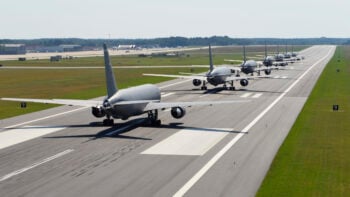
Iraqi air force AC-208 launches a Hellfire missile
WASHINGTON: The Afghan Air Force is about to get a powerful new weapon in what is shaping up to be a bloody year in the 17-year-old war against the Taliban.
On Friday, the U.S. Air Force announced an $86 million deal with an American defense contractor Orbital ATK to supply single-engine, turboprop AC-208 airplanes to the Kabul government. The aircraft — dubbed the Eliminator — are designed to deploy with precision-guided munitions and surveillance systems, making them purpose-built for hunting down small groups of insurgent fighters.
Equipped to carry four AGM-114 Hellfire missiles and two 70mm rocket pods capable of carrying a variety of precision rockets, the Eliminator will head into the fight alongside the A-29 Super Tucano aircraft that Afghan pilots already operate, allowing the two planes to team up while allowing the pilots to be in contact with the thousands of American troops freshly deployed to the war to help the government push back against two years of insurgent gains, in part by helping guide bombs onto targets.
A solicitation posted in December to a government web site said the Air Force was looking for seven AC-208s for transfer to the Afghan government, though Orbital declined to put a number on the contract, referring all questions to the Air Force. The Eliminator is based on the unarmed C-208B Grand Caravan aircraft, 24 of which are already being flown by the Afghans in training, transport, and surveillance roles. The deal is being wholly funded by the United States, with $42.3 million from fiscal 2017 funds being used as the initial funding mechanism
The sale comes amid a massive surge in airstrikes by American and Afghan warplanes, with Afghan pilots for the first time taking a leading role in the fight. By the end of 2017, the number of airstrikes flirted with the levels of airpower brought to bear during the massive U.S. troop surge ordered by President Obama in 2010-2012. The strikes had a real effect in halting the Taliban’s slow march toward major population centers, forcing the insurgents to abandon large-scale assaults, and instead relying on hit and run attacks on Afghan police checkpoints, barracks, and civilian targets.
Over the past week, approximately 14 Afghan special operations troops have been killed in small, violent attacks on small, remote outposts in Farah province, while close to 200 civilians were killed in a series of spectacular attacks in Kabul in January.
“The reality has set in that it’s going to be very hard for [the Taliban] to take any provincial capitals,” said Seth Jones, an analyst at the Center for Strategic and International Security who has served as an advisor for military commanders in Afghanistan and elsewhere. Instead, he expects the insurgent groups to focus on civilian attacks while burrowing small groups if fighters within villages to provoke airstrikes that endanger civilians. The leadership of both the Taliban and ISIS are “well aware of the dangers of too many civilian casualties for the war effort in Washington,” Jones told me.
“The Taliban will not focus on conventional military attacks this year,” David Sedney, deputy assistant secretary of defense for Afghanistan, Pakistan, and Central Asia during the first Obama term told me. “That’s what they did from 2014 through 2016,” as the American presence drew down. Rather, “they’re going to focus on these big terrorist attacks in the cities that generate headlines, and take the focus away from the gains made by the army elsewhere.”
Small aircraft like the Afghan air force’s 12 A-29s — they’ll have 25 in the coming years — and the AC-208 are likely to be highly valuable in this kind of fight, given their slow speeds, new communications gear, and precision munitions allowing them to identify and single out targets in a confused landscape.
The Afghans have been conducting about 40 strikes a week, almost double the roughly 25 strikes American aircraft perform, Maj. Gen. James Hecker, commander of the air war in Kabul told reporters at the Pentagon last month.
In 2017, more bombs were dropped on Afghanistan than all of 2015 and 2016 combined. But a United Nations report released last month reported that the civilian casualty rate increased just seven percent in 2017 from the previous year, reaching 631 civilian casualties, including 295 dead. In response, spokesman for the U.S.-led coalition in Kabul, Capt. Tom Gresback told me, “we do not agree with that estimate,” putting the count at 19 civilians dead, and 32 wounded as result of US/Afghan airstrikes.
Thomas Ruttig, co-founder of the Afghanistan Analysts Network, said he is particularly concerned about the impact the coming wave of airstrikes will have on civilians. “We have seen in the past how that can serve as a recruitment tool for the Taliban,” he said, “and we have also seen territorial gains of the Taliban when airstrike figures were approximately as high as now in the last Obama years.”
Army inching towards late FY25 Chinook Block II full-rate production contract
Boeing recently announced the Block II helo’s first maiden flight and plans to deliver the first production aircraft to the service in the coming weeks.


























